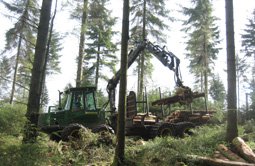Paper examines the economics of transforming a stand of Sitka spruce to Continuous Cover Forestry
 Recently continuous cover forestry (CCF) has become an accepted approach to forest management in Britain, but uncertainty about its economic consequences may be a barrier to its wider use. A study was carried out to examine the costs and revenues of transforming a stand of Sitka spruce (Picea sitchensis (Bong.) Carr.) to CCF. The main conclusion is that transformation to CCF need not be more costly than clearfelling and replanting if natural regeneration is successful and the aim is to produce a simple canopy structure. The long-term value of transformation to a more complex canopy structure, with three or more strata, is lower and the extra costs need to be justified in terms of management objectives. The main output from the study is an analysis spreadsheet that empowers practitioners and policymakers to investigate the effects of costs, revenues and discount rates on estimates of net present value over 20 years, 100 years and in perpetuity, to suit local conditions. This paper summarises the method and results of the study in a British context, sets these in a wider international context, and considers the merits, applications and possible further developments of the approach.
Recently continuous cover forestry (CCF) has become an accepted approach to forest management in Britain, but uncertainty about its economic consequences may be a barrier to its wider use. A study was carried out to examine the costs and revenues of transforming a stand of Sitka spruce (Picea sitchensis (Bong.) Carr.) to CCF. The main conclusion is that transformation to CCF need not be more costly than clearfelling and replanting if natural regeneration is successful and the aim is to produce a simple canopy structure. The long-term value of transformation to a more complex canopy structure, with three or more strata, is lower and the extra costs need to be justified in terms of management objectives. The main output from the study is an analysis spreadsheet that empowers practitioners and policymakers to investigate the effects of costs, revenues and discount rates on estimates of net present value over 20 years, 100 years and in perpetuity, to suit local conditions. This paper summarises the method and results of the study in a British context, sets these in a wider international context, and considers the merits, applications and possible further developments of the approach.
Read Comparing the Costs and Revenues of Transformation to Continuous Cover Forestry for Sitka Spruce in Great Britain.
Forests 2015, 6, 2424-2449
Authors: Davies, O., Kerr, G. (2015)
